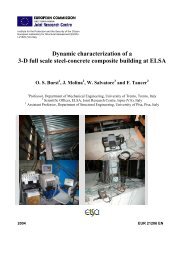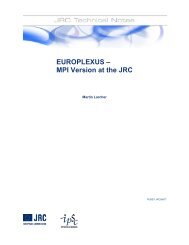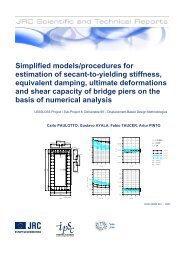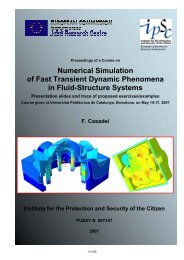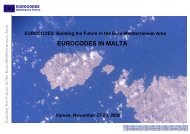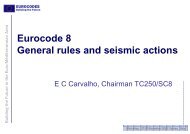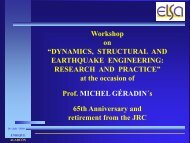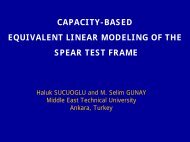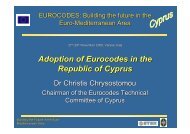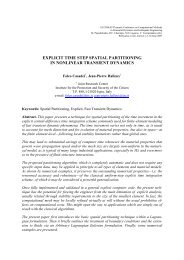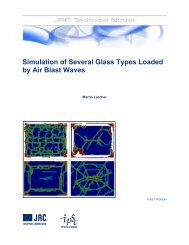(Italy) Earthquake of 24 November 2004: A Field Report
(Italy) Earthquake of 24 November 2004: A Field Report
(Italy) Earthquake of 24 November 2004: A Field Report
- No tags were found...
You also want an ePaper? Increase the reach of your titles
YUMPU automatically turns print PDFs into web optimized ePapers that Google loves.
EUROPEAN COMMISSIONJOINT RESEARCH CENTREInstitute for the Protection and Security <strong>of</strong> the CitizenEuropean Laboratory for Structural Assessment (ELSA)I-21020 Ispra (VA), <strong>Italy</strong>The Garda Area (<strong>Italy</strong>) <strong>Earthquake</strong> <strong>of</strong> <strong>24</strong> <strong>November</strong> <strong>2004</strong>:A <strong>Field</strong> <strong>Report</strong>S. Dimova, E. Mola, P. Negro, A.V. PintoA. Colombo (University <strong>of</strong> Trento)GAVARDO STATION GROUND ACCELERATION RECORD: W-ECOMPONENT403020Acceleration [cm/s2]1000 2 4 6 8 10 12-10-20-30-4014-50Time [s]<strong>2004</strong> EUR 21513 EN
The Garda Lake (<strong>Italy</strong>) earthquake <strong>of</strong> <strong>24</strong> <strong>November</strong> <strong>2004</strong>: A field reportCONTENTSContents................................................................................................................................ iList <strong>of</strong> figures .....................................................................................................................iiiList <strong>of</strong> tables ....................................................................................................................... ivAknowledgements ............................................................................................................... vAbstract..............................................................................................................................vii1 Introduction ................................................................................................................. 12 Seismology and geological aspects ............................................................................. 32.1 Geology and tectonics ......................................................................................... 32.2 Historic seismicity ............................................................................................... 42.3 Description <strong>of</strong> the earthquake <strong>of</strong> <strong>24</strong> <strong>November</strong> <strong>2004</strong>.......................................... 52.4 Strong motion records ......................................................................................... 92.5 References.......................................................................................................... 123 Damage distribution: observed microseismic intensity............................................. 133.1 Vulnerability class according to the European Macroseismic Scale................ 133.2 Vobarno ............................................................................................................. 133.3 Collio (fraction <strong>of</strong> Vobarno).............................................................................. 143.4 Pompegnino (fraction <strong>of</strong> Vobarno) ................................................................... 153.5 Pavone (fraction <strong>of</strong> Sàbbio Chiese)................................................................... 163.6 Clibbio (fraction <strong>of</strong> Sàbbio Chiese)................................................................... 173.7 References.......................................................................................................... 194 Performance <strong>of</strong> building structures ........................................................................... 214.1 Non-engineered masonry houses....................................................................... 214.2 Engineered structures........................................................................................ 254.2.1 Masonry structures with reinforced concrete slabs ................................... 254.2.2 Reinforced concrete structures .................................................................. 254.3 Conclusion......................................................................................................... 275 Socio-economic effects and management <strong>of</strong> the disaster.......................................... 29i
The Garda Lake (<strong>Italy</strong>) earthquake <strong>of</strong> <strong>24</strong> <strong>November</strong> <strong>2004</strong>: A field report5.1 General ..............................................................................................................295.2 Statistics .............................................................................................................305.2.1 Emergency operations................................................................................305.2.2 Damage and economic losses ....................................................................315.3 References..........................................................................................................336 Conclusions................................................................................................................35ANNEX A..........................................................................................................................37ANNEX B……………………………………………………………………………… 41ii
The Garda Lake (<strong>Italy</strong>) earthquake <strong>of</strong> <strong>24</strong> <strong>November</strong> <strong>2004</strong>: A field reportLIST OF FIGURESFigure 2.1. Map <strong>of</strong> events with M ≤ 4 for the Mediterranean area .......................................Figure 2.2. Map <strong>of</strong> the events with M>4 for the Mediterranean area ...................................Figure 2.3. Historical earthquakes, 2002 events and tectonic configuration <strong>of</strong> the area.......Figure 2.4. Epicentre <strong>of</strong> the earthquake FigureFigure 2.5. Map <strong>of</strong> the epicentral area (from the C.O.M. in Salò) ........................................Figure 2.6 Seismic Classification Map for Lombardia (from [6]) ........................................Figure 2.7 Moment tensor solution for the main shock.........................................................Figure 2.8. Tectonics <strong>of</strong> the Lake Garda area........................................................................Figure 2.9. Historical earthquakes, 2002 events and tectonic configuration <strong>of</strong> the area.......Figure 2.10. Location <strong>of</strong> the accelerometric stations in the epicentral area (from [8]) .........Figure 2.11. The Gavardo station records <strong>of</strong> the main shock (NS, WE and verticalcomponents) ..................................................................................................................Figure 2.12. Elastic spectrum for the Gavardo station record <strong>of</strong> the main shock .................Figure 2.13. Inelastic spectra for the main component (N-S) <strong>of</strong> the Gavardo station record<strong>of</strong> the main shock...........................................................................................................Figure 3.1. A church in Vobarno...........................................................................................Figure 3.2. Slight non-structural damage ..............................................................................Figure 3.3. Damage <strong>of</strong> a concrete flower pot in Vobarno .....................................................Figure 3.4. Fall <strong>of</strong> loose bricks in Collio...............................................................................Figure 3.5. Cracks in the masonry walls ...............................................................................Figure 3.6. Failure <strong>of</strong> masonry wall ......................................................................................Figure 3.7. Separation joint in RC building ..........................................................................Figure 3.8. Collapsed masonry wall ......................................................................................Figure 3.9. Deplanation and cracking <strong>of</strong> a masonry wall......................................................Figure 3.10. Lack <strong>of</strong> separation joint.....................................................................................Figure 3.11. Failure <strong>of</strong> the masonry under the ro<strong>of</strong>...............................................................Figure 3.12. Failure <strong>of</strong> masonry with poor quality................................................................Figure 3.13. Shear failure <strong>of</strong> masonry column ......................................................................Figure 3.14. Failure <strong>of</strong> untied slender masonry wall.............................................................Figure 3.15. Failure <strong>of</strong> the masonry under the ro<strong>of</strong>...............................................................Figure 3.16. Pounding <strong>of</strong> adjacent buildings.........................................................................Figure 3.17. Fallen ‘coppi’ tiles.............................................................................................Figure 3.18. Damages <strong>of</strong> the church......................................................................................Figure 3.19. Partial separation <strong>of</strong> the façade walls................................................................Figure 3.20. Rock-fall near Clibbio.......................................................................................Figure 4.1. House in Clibbio with a large opening in the bearing wall.................................Figure 4.2. Separation <strong>of</strong> infills in Collio..............................................................................Figure 4.3. Failure <strong>of</strong> the unconfined masonry under the ro<strong>of</strong> in Pompegnino ....................Figure 4.4. Failure <strong>of</strong> the masonry support and <strong>of</strong> the ro<strong>of</strong> in Clibbio..................................Figure 4.5. Separation <strong>of</strong> masonry walls in Pavone ..............................................................Figure 4.6. Irregular structure in Clibbio...............................................................................Figure 4.7. Failure <strong>of</strong> masonry in Pavone .............................................................................Figure 4.8. Sliding <strong>of</strong> ‘coppi’ tiles in Pompegnino ...............................................................Figure 4.9. Renovated house in Pavone ................................................................................Figure 4.10. Renovated house in Pavone ..............................................................................Figure 4.11. The bell-tower in Clibbio..................................................................................Figure 4.12.The bell-tower in Pompegnino...........................................................................iii
The Garda Lake (<strong>Italy</strong>) earthquake <strong>of</strong> <strong>24</strong> <strong>November</strong> <strong>2004</strong>: A field reportFigure 4.13. The church in Clibbio........................................................................................Figure 4.14. The church in Pompegnino................................................................................Figure 4.15. Cracks in the vault <strong>of</strong> the church in Clibbio......................................................Figure 4.16. The church in Pavone ........................................................................................Figure 4.17. Irregular structure in Pavone .............................................................................Figure 4.18. Pounding <strong>of</strong> adjacent buildings in Collio ..........................................................Figure 4.19. Failed thin masonry wall in Collio ....................................................................Figure 4.20. Cracked masonry wall in Pompegnino..............................................................Figure 4.21. Hollow bricks used in Pompegnino...................................................................Figure 4.22. Irregular building in Collio................................................................................Figure 4.23. Separation <strong>of</strong> masonry walls .............................................................................Figure 4.<strong>24</strong>. Pounding <strong>of</strong> adjacent structures in Pompegnino ...............................................Figure 5.1. The Salò C.O.M...................................................................................................Figure 5.2. Map <strong>of</strong> the requested and performed structural safety assessment interventionsat the Salò C.O.M...........................................................................................................Figure 5.3. The Pompegnino C.O.A. .....................................................................................Figure 5.4. The Pompegnino camp kitchen and canteen .......................................................Figure 5.5. Safety intervention on a stone masonry wall.......................................................Figure 5.6. Vigili del Fuoco intervening on the ro<strong>of</strong> <strong>of</strong> a damaged building inPompegnino ...................................................................................................................Figure 5.7. Safety intervention on a masonry house in Pompegnino ....................................Figure 5.8. Vigili del Fuoco working on the ro<strong>of</strong> <strong>of</strong> the heavily damage church in ClibbioFigure 5.9. Intervention on the severely damaged Primary School <strong>of</strong> Pompegnino .............Figure 5.10. Safety intervention in Pavone............................................................................LIST OF TABLESTable 2.1. Minor aftershocks (from the INGV website)........................................................Table 2.2. Recorded data from RAN and temporary accelerometric stations (from [6]) ......Table 5.1. Assisted population in the most damaged villages ...............................................iv
The Garda Lake (<strong>Italy</strong>) earthquake <strong>of</strong> <strong>24</strong> <strong>November</strong> <strong>2004</strong>: A field reportABSTRACTOn <strong>November</strong> <strong>24</strong> <strong>2004</strong> an earthquake hit the area <strong>of</strong> Garda Lake, part <strong>of</strong> the Lombardiaregion in <strong>Italy</strong>. The magnitude <strong>of</strong> the event was estimated in 5.2 on the Richter scale and,at a local level, its effects were remarkable, especially in some municipalities where anintensity <strong>of</strong> VII-VIII on the MCS scale was reached.The importance <strong>of</strong> the event, the vicinity <strong>of</strong> the area, the need to investigate theperformance <strong>of</strong> buildings and structures to the earthquake called for a field mission by theELSA <strong>Earthquake</strong> Engineering Staff. The mission consisted <strong>of</strong> a full-day trip to the area,on December 1 <strong>2004</strong>, one week after the event, when the effects <strong>of</strong> the earthquake and itsconsequences on the environment and the people were still evident.This report presents the evidence collected in the trip by means <strong>of</strong> a completephotographic documentation. Moreover, an introduction regarding the historicalseismicity <strong>of</strong> the region and an estimation <strong>of</strong> the main features <strong>of</strong> the earthquake isprovided. Finally, the behaviour <strong>of</strong> different categories <strong>of</strong> buildings, from masonry onesto reinforced concrete, to historical ones, is analysed and discussed and an overview <strong>of</strong>the procedures used to deal with the emergency is carried out.vii
The Garda Lake (<strong>Italy</strong>) earthquake <strong>of</strong> <strong>24</strong> <strong>November</strong> <strong>2004</strong>: A field reportviii
The Garda Lake (<strong>Italy</strong>) earthquake <strong>of</strong> <strong>24</strong> <strong>November</strong> <strong>2004</strong>: A field report1 INTRODUCTIONOn <strong>November</strong> <strong>24</strong> <strong>2004</strong> an earthquake hit the area <strong>of</strong> the Brescia province around LakeGarda in Lombardia, <strong>Italy</strong>. Though the magnitude <strong>of</strong> the event was 5.2 on the Richterscale, the effects it caused on some <strong>of</strong> the building stock <strong>of</strong> the area were remarkable,given the many historical private and public buildings present in the area and the verylarge majority <strong>of</strong> stone and brick masonry structures in the private housing building stock.The relevance <strong>of</strong> the event, the vicinity <strong>of</strong> the area and the need to investigate theperformance <strong>of</strong> buildings and structures to the earthquake called for a field mission by theELSA Laboratory <strong>Earthquake</strong> Engineering Staff. The mission consisted <strong>of</strong> one full-daytrip around the epicentral area and took place on December 1 <strong>2004</strong>, one week after theevent, when the effects <strong>of</strong> the earthquake and its consequences on the environment andthe people were still evident.The aim <strong>of</strong> the present field report is to carry out a thorough overview <strong>of</strong> the mostsignificant aspects <strong>of</strong> the event, referring to the evidence collected during the field trip, tothe documentation collected in preparation for the mission and to the informationgathered through exchanges with experts and locals met on the field.In Chapter 2 the seismological framework <strong>of</strong> the event is traced, referring to the historicalseismicity <strong>of</strong> the area and to its tectonic configuration; a description <strong>of</strong> the event is thencarried out. In Chapter 3 a description <strong>of</strong> the damage distribution, with the observedmicroseismic intensities, is given. In Chapter 4, a detailed description <strong>of</strong> the damagereported by the different categories <strong>of</strong> structures present in the area is performed;masonry buildings, reinforced concrete buildings, historical churches are considered; aphotographic documentation gives a vivid representation <strong>of</strong> the effects <strong>of</strong> the earthquake.Chapter 5 is devoted to the procedures for dealing with the emergency situation caused bythe earthquakes, in particular data on the homeless, the inspected structures and the otherrelevant statistics that could be collected at the time <strong>of</strong> the visit. Finally, in Chapter 6, theconclusions drawn from the field trip and the survey performed about the event arepresented.1
The Garda Lake (<strong>Italy</strong>) earthquake <strong>of</strong> <strong>24</strong> <strong>November</strong> <strong>2004</strong>: A field report2
The Garda Lake (<strong>Italy</strong>) earthquake <strong>of</strong> <strong>24</strong> <strong>November</strong> <strong>2004</strong>: A field report2 SEISMOLOGY AND GEOLOGICAL ASPECTS2.1 Geology and tectonicsThe Mediterranean basin area has a quite complex tectonic configuration. In thisrelatively small area, in fact, different kinds <strong>of</strong> seismogenetic zones can be found. Some<strong>of</strong> them are characterized by compressive tectonic movements leading to subduction (theAlps or the Hellenic Arch), some others are characterized by elongation and sliding ([1],[2]).The seismic activity in the Italian Peninsula is mainly caused by the convergingmovements <strong>of</strong> the African and the Eurasiatic plates. This causes high seismicity in <strong>Italy</strong>,both from the frequency and from the intensity point <strong>of</strong> view. The events taking place in<strong>Italy</strong> are possibly correlated with those happening on the Eastern coasts <strong>of</strong> the AdriaticSea.The Apennine area shows a mostly diverging tectonic activity, with some areascharacterized by compressive stresses, on the eastern side. This shows a complex activitythat is possibly due to the rotation <strong>of</strong> the Atlantic micro-plate, added to markeddisomogeneity at crustal level. For this reason, the seismicity in <strong>Italy</strong> is quite high, as canbe observed in Figure 2.1, where a map <strong>of</strong> the events with M ≤ 4 in the Mediterraneanarea is represented. In <strong>Italy</strong> such events are present everywhere.Figure 2.1. Map <strong>of</strong> events with M ≤ 4 for the Mediterranean areaFrom Figure 2.2, showing a map <strong>of</strong> events with M > 4, it can be seen that also strongerearthquakes are quite common, especially in certain areas (in the map the squaresrepresent events with 5 ≤ M ≤ 6 and the circles represent events with M 5, reaching 6 for the Irpinia earthquake <strong>of</strong>1980.3
The Garda Lake (<strong>Italy</strong>) earthquake <strong>of</strong> <strong>24</strong> <strong>November</strong> <strong>2004</strong>: A field reportFigure 2.2. Map <strong>of</strong> the events with M>4 for the Mediterranean area2.2 Historic seismicityThe historic seismicity <strong>of</strong> the area <strong>of</strong> Garda Lake is well known. The most relevant eventthat took place in the area was the earthquake <strong>of</strong> 30 October 1901. On that day a verystrong earthquake hit a number <strong>of</strong> municipalities in the province <strong>of</strong> Brescia, part <strong>of</strong> theLombardia region in <strong>Italy</strong>.Figure 2.3. Map from the “Parametric Catalogue <strong>of</strong> Italian <strong>Earthquake</strong>s”, from [3]In Salò, a small town on the Garda Lake, and one <strong>of</strong> the areas damaged by the recentearthquake, the intensity <strong>of</strong> that event reached VIII on the Mercalli Scale. On thatoccasion, diffused cracking to the housing building stock was observed, together with a4
The Garda Lake (<strong>Italy</strong>) earthquake <strong>of</strong> <strong>24</strong> <strong>November</strong> <strong>2004</strong>: A field reportnumber <strong>of</strong> failures; landslides and movements were also reported. In Fig. 2.3 therepresentation <strong>of</strong> that earthquake in the Italian Catalogue <strong>of</strong> Seismic Events is reported(from [3]). In [4], the peculiarity <strong>of</strong> the seismic area <strong>of</strong> Lake Garda is described as beingthe conjunction ring between the Lombardia and Veneto areas, delimited on one side bythe river Adige and on the other by the river Chiese. A description <strong>of</strong> the historicseismicity <strong>of</strong> the area is also given: municipalities such as Salò, Malcesine and Cassoneare reported to have suffered many a strong and localized earthquakes. Among the mostrelevant events, the earthquake <strong>of</strong> 5 January 1892 is cited: it was reportedly most intensein Salò and Vobarno, two <strong>of</strong> the municipalities that were also involved in the latest event.The region being delimited by two seismic epicentral areas located on the two oppositesides <strong>of</strong> the Garda Lake, it has historically resented <strong>of</strong> the activity <strong>of</strong> both: when, on theVeneto side (in the province <strong>of</strong> Verona), periods <strong>of</strong> intense seismicity came along, on theopposite side (in the province <strong>of</strong> Brescia) events were <strong>of</strong>ten registered at the same timestoo.2.3 Description <strong>of</strong> the earthquake <strong>of</strong> <strong>24</strong> <strong>November</strong> <strong>2004</strong>On <strong>24</strong> <strong>November</strong> <strong>2004</strong>, at 23:59 local time (22:59 GMT), a seismic event <strong>of</strong> magnitude5.2 on the Ricther scale hit the area <strong>of</strong> the province <strong>of</strong> Brescia (Lombardia, <strong>Italy</strong>) aroundLake Garda. The main event was followed by a series <strong>of</strong> minor quakes, <strong>of</strong> very smallmagnitude, ranging between 1.7 and 2.1, not felt by the population but recorded by theItalian accelerogram net and reported on the National Institute <strong>of</strong> Geophisics andVulcanology (INGV) website [5].TIME DATE MAGNITUDE00:48 25/11/<strong>2004</strong> Magnitude: 1.700:49 25/11/<strong>2004</strong> Magnitude: less than 1.700:53 25/11/<strong>2004</strong> Magnitude: 1.700:55 25/11/<strong>2004</strong> Magnitude: 1.702:25 25/11/<strong>2004</strong> Magnitude: 2.105:22 25/11/<strong>2004</strong> Magnitude: 2.0Table 2.1. Minor aftershocks (from the INGV website, [5])The location <strong>of</strong> the epicentre <strong>of</strong> the main event can be observed in Fig. 2.4. Acording tothe preliminary report by INGV, the main municipalities located at less than 3 km fromthe epicentre are: Vobarno and Gardone Riviera; in a 6 km radius area from the epicentreare the towns <strong>of</strong> Salò, Sabbio Chiese and Toscolano Maderno. In Fig. 2.5, a more detailedmap <strong>of</strong> the area is represented; the relative positions <strong>of</strong> the small villages <strong>of</strong> Vobarno,Gardone Riviera and Toscolano Maderno can be observed. This map was located in theC.O.M. (Centro Operativo Misto) <strong>of</strong> Salò, the emergency management unit set upimmediately after the event and still operative at the time <strong>of</strong> the field mission (for furtherinformation and a more detailed description <strong>of</strong> the emergency management proceduressee Chapter 5).According to the new Seismic Classification <strong>of</strong> <strong>Italy</strong>, referred to the Nuova OrdinanzaPCM <strong>of</strong> 20 March 2003 [6], the epicentral area is in seismic category 2: as can be seen inthe map represented in Fig. 2.6, from [7], this means that the horizontal groundacceleration value with a probability <strong>of</strong> exceedance <strong>of</strong> 10% in ten years is in the range0.15-0.25g. For the same category, the 0-period horizontal acceleration given is 0.25g.5
The Garda Lake (<strong>Italy</strong>) earthquake <strong>of</strong> <strong>24</strong> <strong>November</strong> <strong>2004</strong>: A field reportThe estimated depth <strong>of</strong> the event was <strong>of</strong> about 8 km: due to the superficial location <strong>of</strong> theepicentre, the earthquake was felt over a very large area <strong>of</strong> <strong>Italy</strong>, from region Lombardiato Veneto, Piemonte (located in North-East and North-West <strong>Italy</strong>, respectively), toToscana and Emilia-Romagna (located in the centre <strong>of</strong> the Italian peninsula), toSwitzerland, Austria and Slovenia.Preliminary moment-tensor solutions for this earthquake carried out by the United StatesGeological Survey, [8], imply that the shock occurred as the result <strong>of</strong> movement on aninverted fault, as represented in Fig. 2.7. In the picture, the ‘beach ball’ representation <strong>of</strong>the source mechanism for the earthquake is given, together with the slip, dip and strikedata that locate and describe it exactly. This solution was performed by INGV-HarvardEuropean-Mediterranean Regional Centroid-Moment Tensors Project.The tectonics <strong>of</strong> the area is represented in Fig. 2.8: the main active tectonic structures arereported, together with the epicentres <strong>of</strong> some historic earthquakes. The event under studywas part <strong>of</strong> the activity <strong>of</strong> the Giudicarie fault system.Figure 2.4. Epicentre <strong>of</strong> the earthquakeIn Fig. 2.9, the epicentre <strong>of</strong> the <strong>24</strong> <strong>November</strong> earthquake and its focal mechanism arecompared to the cinematic sources <strong>of</strong> the seismogenetic system which caused the 1901earthquake (the source is the new version, yet to be published, <strong>of</strong> the Database <strong>of</strong>potential Sources for <strong>Earthquake</strong>s larger than M 5.5 in <strong>Italy</strong>, 2001). It can be seen thatthe recent earthquake is well framed in the activity <strong>of</strong> the Giudicarie System: both thetype <strong>of</strong> mechanism (inverted fault) and its direction (strike) are in good agreement withthis conclusion.6
The Garda Lake (<strong>Italy</strong>) earthquake <strong>of</strong> <strong>24</strong> <strong>November</strong> <strong>2004</strong>: A field reportFigure 2.5. Map <strong>of</strong> the epicentral area (from the C.O.M. in Salò)Fig. 2.6 Seismic Classification Map for Lombardia (from [7])7
The Garda Lake (<strong>Italy</strong>) earthquake <strong>of</strong> <strong>24</strong> <strong>November</strong> <strong>2004</strong>: A field reportFigure 2.7 Moment tensor solution for the main shockFigure 2.8. Tectonics <strong>of</strong> the Lake Garda area8
The Garda Lake (<strong>Italy</strong>) earthquake <strong>of</strong> <strong>24</strong> <strong>November</strong> <strong>2004</strong>: A field reportFigure 2.9. Historical earthquakes, 2002 events and tectonic configuration <strong>of</strong> the area2.4 Strong motion recordsAs reported in [9], following the main event <strong>of</strong> <strong>24</strong> <strong>November</strong> the Italian RAN Network(National Accelerometric Network) station <strong>of</strong> Gavardo, located at less than 10 km fromthe epicentre, was activated.Fig. 2.10. Location <strong>of</strong> the accelerometric stations in the epicentral area (from [9])9
The Garda Lake (<strong>Italy</strong>) earthquake <strong>of</strong> <strong>24</strong> <strong>November</strong> <strong>2004</strong>: A field reportThe recorded peak ground acceleration (PGA) was around 0.077g (about 76 cm/s 2 ) on thelongitudinal component (NS direction). Gavardo is an analogic measurement station; nodigital stations are located near the epicentral area. In the following the digitalized signalsobtained from the analogic measurements are reported. The only digital station thatrecorded a signal is located in the Gran Sasso area, in the Abruzzo region, at more than500 km from the epicentre. In the latter station the recorded PGA was <strong>of</strong> 0.023 cm/s 2 .Starting from the afternoon <strong>of</strong> 25 <strong>November</strong>, three temporary digital stations were set upin the area: one <strong>of</strong> them was located at the Salò C.O.M. (Centro Operativo Misto,described in detail in Chapter 5); the other two stations were located in ToscolanoMaderno, one <strong>of</strong> them on rock soil, the other on s<strong>of</strong>t soil to point out any possible siteeffects. Of the three aftershocks with magnitude ≥ 2.5 reported by INGV, two were alsorecorded by the temporary digital stations.In Fig. 2.10 the map with the location <strong>of</strong> the temporary station is represented. Tab. 2.2gives the PGA values and the magnitudes <strong>of</strong> the main event, as registered in the two RANstations <strong>of</strong> Gavardo and Gran Sasso stations.Tab. 2.2. Recorded data from RAN and temporary accelerometric stations (from [9])Station A/D Place Time Direct. PGA(cm/s 2 ) MagnitudeGVD A Gavardo <strong>24</strong>/11/04 Long. 158.76 5.2(Gazzino) 22:59GVD A Gavardo <strong>24</strong>/11/04 Vert. 91.14 5.2(Gazzino) 22:59GVD A Gavardo <strong>24</strong>/11/04 Trasv. 99.96 5.2(Gazzino) 22:59GSG D Gran <strong>24</strong>/11/04 XTE -0.021 5.2Sasso 22:59GSG D Gran <strong>24</strong>/11/04 YLN. 0.023 5.2Sasso 22:59GSG D Gran <strong>24</strong>/11/04 ZUP -0.022 5.2Sasso 22:59SAS D Salò 26/11/04 XTE 1.618 2.7(SAL)C.O.M. 05:39SAS D Salò 26/11/04 YLN. 1.943 2.7(SAL)C.O.M. 05:39SAS D Salò 26/11/04 ZUP -6.277 2.7(SAL)C.O.M. 05:39GAI D Gaino 27/11/04 XTE 2.751 2.5(bunker) 08:45GAI D Gaino 27/11/04 YLN. -2.507 2.5(bunker) 08:45GAI D Gaino(bunker)27/11/0408:45ZUP 2.018 2.5In Fig. 2.11 the digitalized ground acceleration recorded by the analogic instrumentationin the Gavardo station (provided courtesy <strong>of</strong> the Protezione Civile) is reported. The twohorizontal and the vertical component are represented.10
The Garda Lake (<strong>Italy</strong>) earthquake <strong>of</strong> <strong>24</strong> <strong>November</strong> <strong>2004</strong>: A field reportGAVARDO STATION GROUND ACCELERATION RECORD: N-SCOMPONENTGAVARDO STATION GROUND ACCELERATION RECORD: W-ECOMPONENT804060304020Acceleration [cm/s2]2000 2 4 6 8 10 12 14-20-40Acceleration [cm/s2]1000 2 4 6 8 10 12 14-10-20-30-60-40-80-50Time [s]Time [s]GAVARDO STATION GROUND ACCELERATION RECORD: D-UCOMPONENT403020Acceleration [cm/s2]1000 2 4 6 8 10 12-10-20-30-4014-50Time [s]Fig.2.11 The Gavardo station records <strong>of</strong> the main shock (NS, WE and verticalcomponents)In Fig. 2.12, the elastic spectrum computed for the main shock recorded signal inGavardo is represented. The peak value <strong>of</strong> the spectral acceleration is rather small andthe spectrum exhibits a band concentration <strong>of</strong> high values for high frequenciesGAVARDO STATION RECORD: ELASTIC SPECTRUM FOR W-ECOMPONENTGAVARDO STATION RECORD: ELASTIC SPECTRUM FOR N-SCOMPONENTSa [cm/s2]1601401201008060402000.00 0.50 1.00 1.50 2.00 2.50 3.00 3.50Period [s]Sa [cm/s2]3002502001501005000.00 0.50 1.00 1.50 2.00 2.50 3.00 3.50Period [s]GAVARDO STATION RECORD: ELASTIC SPECTRUM FOR D-UCOMPONENTSa [cm/s2]1601401201008060402000.00 0.50 1.00 1.50 2.00 2.50 3.00 3.50Period [s]Fig.2.12 Elastic spectrum for the Gavardo station record <strong>of</strong> the main shock11
The Garda Lake (<strong>Italy</strong>) earthquake <strong>of</strong> <strong>24</strong> <strong>November</strong> <strong>2004</strong>: A field reportFinally, in Fig. 2.13 a), the inelastic spectra computed for the main component <strong>of</strong> themain shock are reported. The corresponding ductility demand is almost negligible, exceptfor high frequencies.GAVARDO STATION ACCELERATION RECORDS: INELASTICSPECTRA FOR N-S COMPONENT1.61.41.2Ductility Demand10.80.60.40.2q=2.77q=4.9500.00 0.50 1.00 1.50 2.00 2.50 3.00Period [s]Fig.2.13 Inelastic spectra for the main component (N-S) <strong>of</strong> the Gavardo station record <strong>of</strong>the main shock2.5 References1 D. Molin, M. Stucchi & G. Valensise. Massime intensità macroseismiche osservatenei comuni italiani, http://emidius.mi.ingv.it/GNDT/IMAX/imax.html, Dipartimentodella Protezione Civile; 19962 D. Slejko, R. Camassi, I. Cecic, D. Herak, M. Herak, S. Kociu, V. Kouskouna, J.Lapajne, K. Makropoulos, C. Meletti, B. Muco, C. Papaioannou, L. Peruzza, A.Rebez, P. Scandone, E. Sulstarova, N. Voulgaris, M. Zivcic & P. Zupancic. GSHAPseismic hazard assessment for the Adria region, http://seismo.ethz.ch/gshap/adria/,Global Seismic Hazard Assessment Program; 19993 INGV: Istituto Nazionale di ge<strong>of</strong>isica e Vulcanologia, http://www.ingv.it4 M. Baratta, I Terremoti d’Italia, Arnaldo Forni Editore; 19005 INGV: http://www.ingv.it/terremoti/bresciano<strong>2004</strong>/bresciano.html6 Ordinanza PCM del 20 Marzo 2003, N.32747 http://zonesismiche.mi.ingv.it/mappa_ps_apr04/italia.html8 USGS: http://earthquake.usgs.gov/recenteqs/, <strong>Earthquake</strong> Hazards Programme,United States Geological Survey; 2002.9 Protezione Civile: http://www.protezionecivile.it/cms/attach/rapporto_garda.pdf12
The Garda Lake (<strong>Italy</strong>) earthquake <strong>of</strong> <strong>24</strong> <strong>November</strong> <strong>2004</strong>: A field report3 DAMAGE DISTRIBUTION: OBSERVED MICROSEISMIC INTENSITY3.1 Vulnerability class according to the European macroseismic scaleThe observation <strong>of</strong> the affected area has shown that the structural damage is concentratedin the historical centers <strong>of</strong> the villages. There, the prevailing part <strong>of</strong> the building stockconsisted <strong>of</strong> two (rarely three) storey non-engineered masonry houses. Having in mindthat a considerable part <strong>of</strong> these structures during its 200-300 years long exploitation hasbeen subjected to many non-engineered interventions and the observed during the surveycases <strong>of</strong> structural deficiencies (considered in detail in Chapter 4), vulnerability class A isassigned to these buildings. Vulnerability class B is assigned to the well-constructedmasonry buildings and to the masonry buildings with reinforced concrete (RC) floorswith construction deficiencies. Vulnerability class C is assigned to the well-constructedmasonry buildings with reinforced concrete (RC) floors.The European macroseismic scale (EMS), [1], distinguishes groups <strong>of</strong> RC structureswithout earthquake resistant design (ERD), with moderate level <strong>of</strong> ERD and with highlevel <strong>of</strong> ERD. In the affected area ERD for second category <strong>of</strong> seismicity has beenrequired since 1974. The buildings were designed for peak ground acceleration <strong>of</strong> 0.07 g,[2]. According to the recent seismic macrozonation map, [3], an effective groundacceleration <strong>of</strong> 0.15 g is assigned to the affected area. Having in mind the relatively lowmagnitude <strong>of</strong> effective ground acceleration <strong>of</strong> 0.07 g, vulnerability class C is assigned toall RC structures. The quality <strong>of</strong> construction is not considered when attributing thevulnerability class <strong>of</strong> the RC buildings, since only one <strong>of</strong> them had slight non-structuraldamage and no special survey was performed.Since the statistical data about the damage <strong>of</strong> the buildings were not completed at the time<strong>of</strong> the preparation <strong>of</strong> this report, the evaluation <strong>of</strong> the amount <strong>of</strong> the damaged buildings isbased on expert estimation. 710 calls for survey <strong>of</strong> damaged buildings were received inVobarno (including the associated fractions) and 426 in Sabbio Chiese (including theassociated fractions) as <strong>of</strong> 1 <strong>of</strong> December <strong>2004</strong>.The European macroseismic scale and the Modified Mercalli scale are reported for thesake <strong>of</strong> convenience in Annex B.3.2 VobarnoThe few negligibly damaged buildings were concentrated on the deposits along the riverChiese.Very slight non-structural damage was observed in isolated buildings <strong>of</strong> class A and classB: hair-line cracks in plaster <strong>of</strong> the walls, as shown in Figures 3.1 and 3.2. A verticalcrack in the masonry wall and fall <strong>of</strong> plaster was observed in one building, as illustratedin Figure 3.3. Having in mind the above observations EMS intensity <strong>of</strong> V and ModifiedMercalli intensity <strong>of</strong> 5 are assigned to the part <strong>of</strong> Vobarno located along the river.13
The Garda Lake (<strong>Italy</strong>) earthquake <strong>of</strong> <strong>24</strong> <strong>November</strong> <strong>2004</strong>: A field reportFigure 3.1. Cracks in the plaster in a churchin VobarnoFigure 3.2. Cracks in the plaster <strong>of</strong> aBuilding in VobarnoFigure 3.3. Vertical crack in the masonry wall and fall <strong>of</strong> plaster in Vobarno3.3 Collio (fraction <strong>of</strong> Vobarno)In Collio many <strong>of</strong> the masonry buildings <strong>of</strong> class A and few <strong>of</strong> class B suffered slightnon-structural damage: hairline cracks in the walls, fall <strong>of</strong> small pieces <strong>of</strong> plaster, fall <strong>of</strong>loose bricks from the upper parts <strong>of</strong> the buildings (Figure 3.4). Few <strong>of</strong> the masonrybuildings <strong>of</strong> class A suffered cracks in several walls (Figure 3.5) and in isolated casescracking <strong>of</strong> walls <strong>of</strong> the structures <strong>of</strong> class B was observed (Figure 3.6). A failure <strong>of</strong> awall <strong>of</strong> structure <strong>of</strong> class C, provoked by a non-engineered intervention was observed(Figure 4.17). In the RC buildings <strong>of</strong> class C the separation joints acted, as shown inFigure 3.7. On the basis <strong>of</strong> the above observations EMS intensity <strong>of</strong> V/VI and ModifiedMercalli intensity <strong>of</strong> 6 are assigned to Collio.14
The Garda Lake (<strong>Italy</strong>) earthquake <strong>of</strong> <strong>24</strong> <strong>November</strong> <strong>2004</strong>: A field reportFigure 3.4. Fall <strong>of</strong> loose bricks in CollioFigure 3.5. Cracks in the masonry wallsFigure 3.6. Failure <strong>of</strong> masonry wallFigure 3.7. Separation joint in RCbuilding3.4 Pompegnino (fraction <strong>of</strong> Vobarno)Considerable damage <strong>of</strong> the masonry structures was observed in Pompegnino: failure <strong>of</strong>masonry walls <strong>of</strong> poor quality (Figure 3.8), out-<strong>of</strong>-plane deformation and cracking <strong>of</strong>masonry walls (Figure 3.9), failure <strong>of</strong> masonry due to the lack <strong>of</strong> separation jointsbetween buildings with different levels <strong>of</strong> the horizontal elements (Figure 3.10),separation <strong>of</strong> masonry walls from the RC slab, disintegration and failure <strong>of</strong> theunconfined masonry under the ro<strong>of</strong> structures (Figure 3.11), cracking <strong>of</strong> windows piers.The upper part <strong>of</strong> the church bell tower suffered shear failure, it was cracked considerablydue to pounding with an adjacent building, and the façade walls <strong>of</strong> the church wereconsiderably cracked in the upper part.15
The Garda Lake (<strong>Italy</strong>) earthquake <strong>of</strong> <strong>24</strong> <strong>November</strong> <strong>2004</strong>: A field reportFigure 3.8. Collapsed masonry wall Figure 3.9. Out <strong>of</strong> planedeformation and cracking <strong>of</strong> amasonry wallFigure 3.10. Lack <strong>of</strong> separation jointFigure 3.11. Failure <strong>of</strong> the masonry underthe ro<strong>of</strong>Isolated buildings <strong>of</strong> class A suffered damage <strong>of</strong> grade 3 (see Annex B), many buildings<strong>of</strong> class A and few buildings <strong>of</strong> class B and C suffered damage <strong>of</strong> grade 2, many buildings<strong>of</strong> class B suffered damage <strong>of</strong> grade 1, isolated buildings <strong>of</strong> class C (see figure 3.10) alsoexhibited damage <strong>of</strong> grade 2. As a result <strong>of</strong> the observations EMS intensity <strong>of</strong> VI/VIIand Modified Mercalli intensity <strong>of</strong> 7 are assigned to Pompegnino.3.5 Pavone (fraction <strong>of</strong> Sàbbio Chiese)The historical centre <strong>of</strong> Pavone as well as some relatively new buildings sufferedconsiderable damage. There, diagonal cracks in the masonry walls were observed,together with failure <strong>of</strong> walls with poor quality (Figure 3.12), shear failure <strong>of</strong> masonrycolumns (Figure 3.13), out-<strong>of</strong>-plane deformation and cracking <strong>of</strong> slender masonry walls(Figure 3.14), disintegration and failure <strong>of</strong> the unconfined masonry under the ro<strong>of</strong>16
The Garda Lake (<strong>Italy</strong>) earthquake <strong>of</strong> <strong>24</strong> <strong>November</strong> <strong>2004</strong>: A field reportstructures (Figure 3.15). The external observation <strong>of</strong> the Pavone church has shown aslight structural damage.Figure 3.12. Failure <strong>of</strong> masonry with poorqualityFigure 3.13. Shear failure <strong>of</strong> masonryFigure 3.14. Failure <strong>of</strong> untied slendermasonry wallFigure 3.15. Failure <strong>of</strong> the masonry underthe ro<strong>of</strong>Many masonry buildings <strong>of</strong> class A and few buildings <strong>of</strong> class B suffered damage <strong>of</strong>grade 2, most buildings <strong>of</strong> class A and many buildings <strong>of</strong> class B suffered damage <strong>of</strong>17
The Garda Lake (<strong>Italy</strong>) earthquake <strong>of</strong> <strong>24</strong> <strong>November</strong> <strong>2004</strong>: A field report(Figure 3.17). The church was considerably damaged: the upper part <strong>of</strong> the bell towersuffered shear failure (Figure 3.18), the masonry was considerably cracked in manyplaces due to interaction with adjacent structures (Figure 3.18), shear effects and out-<strong>of</strong>planebending. Partial separation <strong>of</strong> the façade walls was observed (Figure 3.19). NearClibbio a rock-fall caused damages <strong>of</strong> the road (Figure 3.20).The observation has shown that many masonry buildings <strong>of</strong> class A and few buildings <strong>of</strong>class B suffered damage <strong>of</strong> grade 2, most buildings <strong>of</strong> class A and many buildings <strong>of</strong>class B suffered damage <strong>of</strong> grade 1. Isolated buildings <strong>of</strong> class C suffered damage <strong>of</strong>grade 2. On this basis EMS intensity <strong>of</strong> VI/VII and Modified Mercalli intensity <strong>of</strong> 7/8are assigned to Clibbio.Figure 3.20. Rock-fall near Clibbio3.7 References1. Conseil de l’Europe. European macroseismic scale 1998 (EMS-98). Cahier duCentre Européen de Géodynamique et de Séismologie, G. Gruenthal, editor.Luxemburg; 15, 1998.2. D.M. Min. LLPP 16 Gennaio 1996, “Norme Tecniche per le Costruzioni in ZoneSismiche” (in Italian)3. Norme tecniche per il progetto, la valutazione e l’adeguamento sismico degli edifici.Rome, 2003. (in Italian)19
The Garda Lake (<strong>Italy</strong>) earthquake <strong>of</strong> <strong>24</strong> <strong>November</strong> <strong>2004</strong>: A field report20
The Garda Lake (<strong>Italy</strong>) earthquake <strong>of</strong> <strong>24</strong> <strong>November</strong> <strong>2004</strong>: A field report4 PERFORMANCE OF BUILDING STRUCTURES4.1 Non-engineered masonry housesThe prevailing part <strong>of</strong> the residential building stock in the observed affected area consists<strong>of</strong> two or three story masonry houses, built before the last World War. The most severelydamaged parts <strong>of</strong> the villages were the historical centers where the houses are 200-300years old. During their long exploitation they were subjected to many reconstructions,which, together with the building techniques from the past and deterioration <strong>of</strong> thematerials contributed their seismic vulnerability. As shown in Figure 4.1, the execution <strong>of</strong>a large opening in the massive contra-force wall contributed its failure. The infills <strong>of</strong> thelarger openings separated and cracked, as shown in Figure 4.2. The new-built untiedslender masonry wall in Pavone suffered out-<strong>of</strong>-plane-deformation and cracked, as shownin Figure 3.14.Figure 4.1. House in Clibbio with a largeopening in the bearing wallFigure 4.2. Separation <strong>of</strong> infills in CollioThe weak connection <strong>of</strong> the ro<strong>of</strong> structures with the unconfined masonry caused failure <strong>of</strong>the masonry (Figure 4.3) and, in some cases failure in the ro<strong>of</strong> structure (Figure 4.4) dueto the damaged supports.Figure 4.3. Failure <strong>of</strong> the unconfinedmasonry under the ro<strong>of</strong> in PompegninoFigure 4.4. Failure <strong>of</strong> the masonry support and<strong>of</strong> the ro<strong>of</strong> in Clibbio21
The Garda Lake (<strong>Italy</strong>) earthquake <strong>of</strong> <strong>24</strong> <strong>November</strong> <strong>2004</strong>: A field reportThe weak connection <strong>of</strong> the floor and ro<strong>of</strong> structures with the masonry as well as theinsufficient in-plane stiffness <strong>of</strong> the floors and ro<strong>of</strong>s did not allow the redistribution <strong>of</strong> theseismic forces between the individual walls. The walls separated along their joints andsuffered out-<strong>of</strong>-plane deformation, as shown in Figure 4.5.Figure 4.5. Separation <strong>of</strong> masonry walls in PavoneFigure 4.6. Irregular structure inClibbioAnother source <strong>of</strong> failure was the lack <strong>of</strong> separation joints between the houses. Adjacentstructures with different height <strong>of</strong> the floors “bumped” against each other causing failure<strong>of</strong> the masonry in the neighbouring parts, as shown in Figure 4.16 for Collio. Theirregular distribution <strong>of</strong> the stiffnesses and masses in-plan and along the height provokedfailures in a house in Clibbio, as shown in Figure 4.6. The use <strong>of</strong> different materials forconstruction <strong>of</strong> the masonry walls caused their cracking and disintegration. In Figure 4.7the failure <strong>of</strong> a masonry wall containing bricks and stones with different size is presented.The horizontal seismic loading caused sliding and failure <strong>of</strong> the ‘coppi’ tiles in manyro<strong>of</strong>s in Clibbio and Pompegnino, as shown in Figure 3.17 and Figure 4.8.Figure 4.7. Failure <strong>of</strong> masonry inPavoneFigure 4.8. Sliding <strong>of</strong> ‘coppi’ tiles in PompegninoIn Pavone, it was observed that old buildings that had even been retr<strong>of</strong>itted or partiallyrehabilitated shortly before the event suffered structural damage (Fig. 4.9-4.10). This22
The Garda Lake (<strong>Italy</strong>) earthquake <strong>of</strong> <strong>24</strong> <strong>November</strong> <strong>2004</strong>: A field reportdamage can be explained by the fact that the rehabilitation interventions had mainly beentargeted to non-structural members and had been designed without taking into properaccount the seismic hazard.Figure 4.9. Renovated house in PavoneFigure 4.10. Renovated house in PavoneThe most heavily damaged parts <strong>of</strong> the churches in Pompegnino and Clibbio were the belltowers. In the two cases the masonry columns framing the upper part at the level <strong>of</strong> thebells are heavily sheared, as shown in Figure 4.11 for Clibbio and Figure 4.12 forPompegnino. These heavy damages are caused by the improperly weak cross-sections <strong>of</strong>the masonry columns in comparison with the earthquake-induced inertial forces to theheavy bells, as well as by a torsional unbalance connected with the positioning <strong>of</strong> thebells with different masses.Figure 4.11. The bell-tower in ClibbioFigure 4.12.The bell-tower in PompegninoThe slender façade walls <strong>of</strong> the two churches were cracked considerably in many placesdue to shear effects and out-<strong>of</strong>-plane bending (Figure 4.13 and Figure 4.14). The observed23
The Garda Lake (<strong>Italy</strong>) earthquake <strong>of</strong> <strong>24</strong> <strong>November</strong> <strong>2004</strong>: A field reportpartial separation <strong>of</strong> the façade walls (Figure 3.19 and Figure 4.12) was most probablyprovoked by a weak connection between the walls and the ro<strong>of</strong>.Figure 4.13. The church in ClibbioFigure 4.14. The church in PompegninoThe vault <strong>of</strong> the church in Clibbio was cracked, as shown in Figure 4.15. The externalobservation <strong>of</strong> the church in Pavone has shown slight structural damage (Figure 4.16).Figure 4.15. Cracks in the vault <strong>of</strong> thechurch in ClibbioFigure 4.16. The church in Pavone<strong>24</strong>
The Garda Lake (<strong>Italy</strong>) earthquake <strong>of</strong> <strong>24</strong> <strong>November</strong> <strong>2004</strong>: A field report4.2 Engineered structures4.2.1 Masonry structures with reinforced concrete slabsMasonry structures with RC slabs suffered much less damage than non-engineeredmasonry structures.Figure 4.17. Irregular structure in PavoneThe RC slabs tied together the masonry walls and redistributed the horizontal loadingbetween them. The most common failures were cracking <strong>of</strong> the plaster and fall <strong>of</strong> smallpieces <strong>of</strong> it. Nevertheless, in isolated cases, masonry structures with RC slabs sufferedmore substantial damage. In a house in Pavone, the lack <strong>of</strong> separation joint between thehouse and the associated structure created an irregular ‘united’ structure and, as aconsequence the masonry in the second story <strong>of</strong> the house was damaged, as well as astone masonry column <strong>of</strong> the penthouse failed in shear (Figure 4.17). The lack <strong>of</strong>separation joint between adjacent buildings caused failure <strong>of</strong> the masonry around thefloors <strong>of</strong> the neighbouring building (Figure 4.18). Non-engineered interventions were alsothe cause <strong>of</strong> damage in the masonry structures with RC slabs. The failed thin masonrywall (Figure 4.19) observed in Collio most probably has been added to the structureduring the reconstruction <strong>of</strong> the former garage in a room.25
The Garda Lake (<strong>Italy</strong>) earthquake <strong>of</strong> <strong>24</strong> <strong>November</strong> <strong>2004</strong>: A field reportFigure 4.18. Pounding <strong>of</strong> adjacentbuildings in CollioFigure 4.19. Failed thin masonry wall inCollioThe quality <strong>of</strong> the masonry contributed substantially the damage <strong>of</strong> the walls. The poorquality <strong>of</strong> the workmanship caused the failure <strong>of</strong> the masonry wall shown in Figure 4.20.The hollow bricks with a small net cross-sectional area and insufficient thickness <strong>of</strong> thecross web and face shells used in some walls turned out to have much lower strength thanthe mortar (Figure 4.21).Figure 4.20. Cracked masonry wall inPompegnino4.2.2 Reinforced concrete structuresFigure 4.21. Hollow bricks used inPompegninoNo major damage was observed in RC structures. The separation joints acted in somebuildings, as shown in Figure 3.7. A slight non-structural damage was observed only inan irregular RC building in Collio, where masonry walls separated from the RC frame.The irregularity was created by the absence <strong>of</strong> masonry walls in a considerable part <strong>of</strong> thefirst story in connection with its exploitation as a workshop (Figure 4.22). The absence <strong>of</strong>masonry walls in this part affected torsional unbalance and to a certain extent a ’s<strong>of</strong>t firststorey’. The resulted separations <strong>of</strong> the masonry walls in the second storey and in thefirst storey are shown in Figure 4.22 and Figure 4.23, respectively.26
The Garda Lake (<strong>Italy</strong>) earthquake <strong>of</strong> <strong>24</strong> <strong>November</strong> <strong>2004</strong>: A field reportFigure 4.22. Irregular building in CollioFigure 4.23. Separation <strong>of</strong> masonry wallsThe lack <strong>of</strong> separation joints between RC buildings and older structures created poundingeffects. The single-storey RC structure heavily damaged the adjacent masonry building inPompegnino, as shown in Figure 4.<strong>24</strong>.Figure 4.<strong>24</strong>. Pounding <strong>of</strong> adjacent structures in Pompegnino4.3 ConclusionThe observation has shown that structures <strong>of</strong> good quality that had been properlydesigned for non-seismic conditions did not suffer structural damage. On the other hand,the earthquake caused significant damage to non-engineered masonry residentialbuildings and churches. The most severely damaged parts <strong>of</strong> the villages were thehistorical centres where the houses are 200-300 years old. The weak connection <strong>of</strong> themasonry walls with the ro<strong>of</strong> and floor structures, the poor quality <strong>of</strong> workmanship andbricks, the lack <strong>of</strong> separation joints, the irregularities <strong>of</strong> the structures and the improper27
The Garda Lake (<strong>Italy</strong>) earthquake <strong>of</strong> <strong>24</strong> <strong>November</strong> <strong>2004</strong>: A field reportreconstructions were the main sources <strong>of</strong> structural damage. The presence <strong>of</strong> ties in animportant part <strong>of</strong> the existing masonry buildings prevented their partial collapse.Finally, it was observed that even old buildings that had been retr<strong>of</strong>itted or partiallyrehabilitated shortly before the event suffered structural damage. This was due to the factthat the rehabilitation interventions had mainly been targeted to non-structural membersand had been designed without taking into proper account the seismic hazard.28
The Garda Lake (<strong>Italy</strong>) earthquake <strong>of</strong> <strong>24</strong> <strong>November</strong> <strong>2004</strong>: A field report5 SOCIO-ECONOMIC EFFECTS AND EMERGENCY MANAGEMENT5.1 GeneralThe emergency situation in the Garda area was managed by a number <strong>of</strong> operatorsrepresenting different governative or non-governative agencies and institutions,coordinated by Protezione Civile (Emergency Management Unit <strong>of</strong> the ItalianGoverment), [1]. The centres where the field authority was concentrated wereimmediately established in some nevralgic small villages <strong>of</strong> the area. The main centre wasthe C.O.M. (the acronym for “Centro Operativo Misto”, translation <strong>of</strong> Multi-taskingOperational Centre) arranged in Salò. As the name says, this kind <strong>of</strong> centre has theauthority to operate in the emergency dealing with all possible kinds <strong>of</strong> problems. TheSalò C.O.M. became active in the first hours after the event and was still operational atthe time <strong>of</strong> the field mission (one week after the event). The main emergencies had allbeen dealt with, but no prevision on the date <strong>of</strong> dismantling <strong>of</strong> the Centre was anticipated.The C.O.M., retaining the decisional power and the majority <strong>of</strong> contacts with the externalinstitutions, was at first established in the Auditorium <strong>of</strong> the Secondary School <strong>of</strong> Salòand later moved to the Gymnasium <strong>of</strong> the same building, due to the need <strong>of</strong> more room toaccommodate the different operative units. Other operative centres were established in themost severely stricken villages: they were named C.O.As, acronym for (“CentroOperativo Avanzato, meaning they were right on the spot where most <strong>of</strong> the damage andemergency intervention requests were concentrated). The C.O.A. that was visited duringthe field mission was located in Pompegnino, fraction <strong>of</strong> Vobarno.The functions <strong>of</strong> the C.O.M.s and, subordinately, <strong>of</strong> the C.O.A.s are several:• Assistance to Local Authorities• Damage estimation• Administrative support• Transportation and road management• Public safety• Historical and cultural monuments preservation• Information and public relations• Urgent technical services and dangerous materials• Scientific research and planning• Public health• Evacuation and logistics• Volunteering coordination• Telecommunications• General secretariatDuring the field mission contacts were taken with the Mayor <strong>of</strong> Vobarno, who was sokind as to personally give the ELSA team a picture <strong>of</strong> the damage distribution in hisvillage and the relevant statistics for Vobarno, reported in the following. Moreover, hegranted our team access to the fraction <strong>of</strong> Pompegnino, which had suffered the mostsignificant damage, so that contact could be taken with Mr. Cadenelli from the localC.O.A., who led the team on a tour <strong>of</strong> the village to gather the photographicdocumentation reported above.29
The Garda Lake (<strong>Italy</strong>) earthquake <strong>of</strong> <strong>24</strong> <strong>November</strong> <strong>2004</strong>: A field reportFigure 5.1. The Salò C.O.M.Figure 5.2. Map <strong>of</strong> the requested and performedstructural safety assessment interventions at theSalò C.O.M.Figure 5.3. The Pompegnino C.O.A.Figure 5.4. The Pompegnino camp kitchenand canteenDuring the visit to the Salò C.O.M. contacts were taken with volunteers from RegioneLombardia, who were very helpful in providing us with the general statistics <strong>of</strong> the safetyassessment interventions for the area, as reported in the following.Moreover, contacts were taken with Pr<strong>of</strong>essor Riva from the University <strong>of</strong> Brescia, whowas also visiting the area with the task <strong>of</strong> estimating the safety <strong>of</strong> the building stock.5.2 Statistics5.2.1 Emergency operationsThe emergency interventions in the area seemed appropriate, as for timing and efficiency.Starting from the very early hours after the event, Italian Protezione Civile took action:Vigili del Fuoco (Fire Brigade) and the Police were sent to the affected areas and damageemergency surveys were carried out. The C.O.M. was immediately set up in Salò.Regione Lombardia took charge <strong>of</strong> the management <strong>of</strong> the structural safety assessment30
The Garda Lake (<strong>Italy</strong>) earthquake <strong>of</strong> <strong>24</strong> <strong>November</strong> <strong>2004</strong>: A field reportinterventions, carried out by qualified experts from the Municipalities and from theLombardia Region together with Vigili del Fuoco. The Police (Forze dell’Ordine, whichin <strong>Italy</strong> are represented by different corps, Carabinieri, Polizia di Stato and Guardia diFinanza) and the Italian Army, represented by the Alpini Corp, also had key roles in theinitial phases <strong>of</strong> the emergency.Moreover, according to the information received at the Salò C.O.M., a total <strong>of</strong> 300volunteers were present, mainly from Lombardia, who provided useful and very effectivehelp in all the operational tasks. The Italian Red Cross provided volunteers too.As <strong>of</strong> the day <strong>of</strong> the visit, no <strong>of</strong>ficial statistics were available regarding the emergencyinterventions and the damage survey and estimation. Anyhow, partial statistics wereprovided by the Salò C.O.M., about the intervention requests, performed safetyverifications and certified damage in the 62 Municipalities involved in the emergency.Table 5.1. Assisted population in the most damaged villagesEvacuatedPop.Village Pop. InterventionRequestsDamage to publicBuildingsVobarno (Total) 7600 720 170 Primary School (Partial),Churches in Pompegninoand Carpeneda (Severe)Sabbio Chiese 3172 426 125 Municipality (Partial)Primary School,Kindergarten (Severe)Salò 10056 1612 330 Primary and SecondarySchool, Kindergarten(Partial), some roadsclosedVillanuova sulClisi4776 345 29 Municipality (Severe),Primary SchoolToscolano 7004 214 25 Some roads interruptedMadernoRoe’ Volciano 4174 500 127 All the ChurchesTotal (62Municipalities)/ 6070 1187(Severe)In Tab. 5.1, the data for the most affected villages are reported; in the last row the totaldata for all the 62 Municipalities are given (the data on the population were taken from[2]).In Annex A the <strong>of</strong>ficial document for the request <strong>of</strong> intervention, that had to be filled inby the inhabitants <strong>of</strong> the damaged buildings, can be found.5.2.2 Damage and economic lossesAt present, no economic estimation <strong>of</strong> the damage has been carried out yet. At the time <strong>of</strong>the visit, Regione Lombardia and the Italian Government had allocated 10 million Euroseach, for the emergency and urgent interventions. Further economic help to the affectedMunicipalities was foreseen as soon as reliable estimations <strong>of</strong> the needed interventionswill be available.31
The Garda Lake (<strong>Italy</strong>) earthquake <strong>of</strong> <strong>24</strong> <strong>November</strong> <strong>2004</strong>: A field reportA sample <strong>of</strong> the emergency safety interventions carried out on buildings at risk <strong>of</strong> partialfailure are reported in Fig. 5.5-5.10.Figure 5.5. Safety intervention on a stonemasonry wallFigure 5.6. Vigili del Fuoco intervening on thero<strong>of</strong> <strong>of</strong> a damaged building in PompegninoFigure 5.7. Vigili del Fuoco vehicles inPompegninoFigure 5.8. Vigili del Fuoco working on thero<strong>of</strong> <strong>of</strong> the heavily damaged church in ClibbioFigure 5.9. Intervention on a severely damagedbuilding in PompegninoFigure 5.10. Safety intervention in Collio32
The Garda Lake (<strong>Italy</strong>) earthquake <strong>of</strong> <strong>24</strong> <strong>November</strong> <strong>2004</strong>: A field report5.3 References1. Protezione Civile, http://www.protezionecivile.it/2. Comuni Italiani, http://www.comuni-italiani.it33
The Garda Lake (<strong>Italy</strong>) earthquake <strong>of</strong> <strong>24</strong> <strong>November</strong> <strong>2004</strong>: A field report34
The Garda Lake (<strong>Italy</strong>) earthquake <strong>of</strong> <strong>24</strong> <strong>November</strong> <strong>2004</strong>: A field report6 CONCLUSIONSThe earthquake <strong>of</strong> <strong>24</strong> <strong>November</strong> <strong>2004</strong> was an event <strong>of</strong> average relevance, with no majorfeatures <strong>of</strong> intensity, damage caused or casualties.The impact <strong>of</strong> the event was thus mainly confined at a local level. Damage <strong>of</strong> a certainextent developed only in older masonry structures, without engineered lateral loadresistance and built with poor technology and bad quality workmanship.Old constructions, such as 200- or 300-year-old houses or churches, suffered significantdamage: this was probably the worst consequence <strong>of</strong> the earthquake, in terms <strong>of</strong> localheritage.The warning that must be once again derived from such an event is on the seismicinadequacies <strong>of</strong> a relatively vast number <strong>of</strong> housing buildings, even in otherwise welldevelopedareas <strong>of</strong> <strong>Italy</strong>. The effects <strong>of</strong> good workmanship and structural detailing (suchas the presence <strong>of</strong> ties) in avoiding major collapse even in relatively poor structures werealso made clear; on the contrary, poor structural detailing and careless repair and/orchange-<strong>of</strong>-use interventions turned out to be a major source <strong>of</strong> vulnerability, even forrelatively good structures. Moreover, it was observed that even old buildings that hadbeen retr<strong>of</strong>itted or partially rehabilitated shortly before the event suffered structuraldamage. This was due to the fact that the rehabilitation interventions had mainly beentargeted to non-structural members and had been designed without taking into properaccount the seismic hazard.As for the impact on population, though, even if no casualties were originated by theevent, the feeling <strong>of</strong> local authorities was that the importance <strong>of</strong> the consequences for asignificant part <strong>of</strong> the local people was underrated or thoroughly neglected by the mediawhich, to a certain extent, made it even more difficult for them to cope with the lossesand the troubles.This report is mainly intended to contributing towards a better understanding anddocumentation <strong>of</strong> the impact <strong>of</strong> the event from an engineering point <strong>of</strong> view, with theadditional hope that, through this, a more objective and comprehensive picture <strong>of</strong> thelocal situation will be drawn.35
The Garda Lake (<strong>Italy</strong>) earthquake <strong>of</strong> <strong>24</strong> <strong>November</strong> <strong>2004</strong>: A field report36
The Garda Lake (<strong>Italy</strong>) earthquake <strong>of</strong> <strong>24</strong> <strong>November</strong> <strong>2004</strong>: A field reportANNEX APost-earthquake damage evaluation forms, as provided by Italian Protezione Civile.37
The Garda Lake (<strong>Italy</strong>) earthquake <strong>of</strong> <strong>24</strong> <strong>November</strong> <strong>2004</strong>: A field report38
The Garda Lake (<strong>Italy</strong>) earthquake <strong>of</strong> <strong>24</strong> <strong>November</strong> <strong>2004</strong>: A field report39
The Garda Lake (<strong>Italy</strong>) earthquake <strong>of</strong> <strong>24</strong> <strong>November</strong> <strong>2004</strong>: A field report40
The Garda Lake (<strong>Italy</strong>) earthquake <strong>of</strong> <strong>24</strong> <strong>November</strong> <strong>2004</strong>: A field reportANNEX BEUROPEAN MACROSEISMIC INTENSITY SCALEClassifications used in the European Macroseismic Scale (EMS)Differentiation <strong>of</strong> structures (buildings) into vulnerability classes(Vulnerability Table)The masonry types <strong>of</strong> structures are to be read as, e.g., simple stone masonry, whereas thereinforced concrete (RC) structure types are to be read as, e.g., RC frame or RC wall.See section 2 <strong>of</strong> the Guidelines and Background Materials for more details, also withrespect to the use <strong>of</strong> structures with earthquake resistant design.Classification <strong>of</strong> damage41
The Garda Lake (<strong>Italy</strong>) earthquake <strong>of</strong> <strong>24</strong> <strong>November</strong> <strong>2004</strong>: A field reportNote: the way in which a building deforms under earthquake loading depends on thebuilding type. As a broad categorisation one can group together types <strong>of</strong> masonrybuildings as well as buildings <strong>of</strong> reinforced concrete.Classification <strong>of</strong> damage to masonry buildingsGrade 1: Negligible to slight damage(no structural damage,slight non-structural damage)Hair-line cracks in very few walls.Fall <strong>of</strong> small pieces <strong>of</strong> plaster only.Fall <strong>of</strong> loose stones from upper parts <strong>of</strong>buildings in very few cases.Grade 2: Moderate damage(slight structural damage, moderatenon-structural damage)Cracks in many walls.Fall <strong>of</strong> fairly large pieces <strong>of</strong> plaster.Partial collapse <strong>of</strong> chimneys.Grade 3: Substantial to heavy damage(moderate structural damage,heavy non-structural damage)Large and extensive cracks in most walls.Ro<strong>of</strong> tiles detach. Chimneys fracture at the ro<strong>of</strong>line; failure <strong>of</strong> individual non-structuralelements (partitions, gable walls).Grade 4: Very heavy damage(heavy structural damage,very heavy non-structural damage)Serious failure <strong>of</strong> walls; partial structuralfailure <strong>of</strong> ro<strong>of</strong>s and floors.42
The Garda Lake (<strong>Italy</strong>) earthquake <strong>of</strong> <strong>24</strong> <strong>November</strong> <strong>2004</strong>: A field reportGrade 5: Destruction(very heavy structural damage)Total or near total collapse.Classification <strong>of</strong> damage to buildings <strong>of</strong> reinforced concreteGrade 1: Negligible to slight damage(no structural damage,slight non-structural damage)Fine cracks in plaster over frame members orin walls at the base.Fine cracks in partitions and infills.Grade 2: Moderate damage(slight structural damage,moderate non-structural damage)Cracks in columns and beams <strong>of</strong> frames and instructural walls.Cracks in partition and infill walls; fall <strong>of</strong>brittle cladding and plaster. Falling mortarfrom the joints <strong>of</strong> wall panels.Grade 3: Substantial to heavy damage(moderate structural damage,heavy non-structural damage)Cracks in columns and beam column joints <strong>of</strong>frames at the base and at joints <strong>of</strong> coupledwalls. Spalling <strong>of</strong> conrete cover, buckling <strong>of</strong>reinforced rods.Large cracks in partition and infill walls,failure <strong>of</strong> individual infill panels.Grade 4: Very heavy damage(heavy structural damage,very heavy non-structural damage)Large cracks in structural elements with43
The Garda Lake (<strong>Italy</strong>) earthquake <strong>of</strong> <strong>24</strong> <strong>November</strong> <strong>2004</strong>: A field reportcompression failure <strong>of</strong> concrete and fracture <strong>of</strong>rebars; bond failure <strong>of</strong> beam reinforced bars;tilting <strong>of</strong> columns. Collapse <strong>of</strong> a few columnsor <strong>of</strong> a single upper floor.Definitions <strong>of</strong> quantityGrade 5: Destruction(very heavy structural damage)Collapse <strong>of</strong> ground floor or parts (e. g. wings)<strong>of</strong> buildings.Definitions <strong>of</strong> intensity degreesArrangement <strong>of</strong> the scale:a) Effects on humansb) Effects on objects and on nature(effects on ground and ground failure are dealt with especially in Section 7)c) Damage to buildingsIntroductory remark:The single intensity degrees can include the effects <strong>of</strong> shaking <strong>of</strong> the respective lowerintensity degree(s) also, when these effects are not mentioned explicitly.I. Not felta) Not felt, even under the most favourable circumstances.b) No effect.c) No damage.44
The Garda Lake (<strong>Italy</strong>) earthquake <strong>of</strong> <strong>24</strong> <strong>November</strong> <strong>2004</strong>: A field reportII. Scarcely felta) The tremor is felt only at isolated instances (
The Garda Lake (<strong>Italy</strong>) earthquake <strong>of</strong> <strong>24</strong> <strong>November</strong> <strong>2004</strong>: A field reportc) Damage <strong>of</strong> grade 1 is sustained by many buildings <strong>of</strong> vulnerability class A and B; afew <strong>of</strong> class A and B suffer damage <strong>of</strong> grade 2; a few <strong>of</strong> class C suffer damage <strong>of</strong> grade 1.VII. Damaginga) Most people are frightened and try to run outdoors. Many find it difficult to stand,especially on upper floors.b) Furniture is shifted and top-heavy furniture may be overturned. Objects fall fromshelves in large numbers. Water splashes from containers, tanks and pools.c) Many buildings <strong>of</strong> vulnerability class A suffer damage <strong>of</strong> grade 3; a few <strong>of</strong> grade 4.Many buildings <strong>of</strong> vulnerability class B suffer damage <strong>of</strong> grade 2; a few <strong>of</strong> grade 3.A few buildings <strong>of</strong> vulnerability class C sustain damage <strong>of</strong> grade 2.A few buildings <strong>of</strong> vulnerability class D sustain damage <strong>of</strong> grade 1.VIII. Heavily damaginga) Many people find it difficult to stand, even outdoors.b) Furniture may be overturned. Objects like TV sets, typewriters etc. fall to the ground.Tombstones may occasionally be displaced, twisted or overturned. Waves may be seen onvery s<strong>of</strong>t ground.c) Many buildings <strong>of</strong> vulnerability class A suffer damage <strong>of</strong> grade 4; a few <strong>of</strong> grade 5.Many buildings <strong>of</strong> vulnerability class B suffer damage <strong>of</strong> grade 3; a few <strong>of</strong> grade 4.Many buildings <strong>of</strong> vulnerability class C suffer damage <strong>of</strong> grade 2; a few <strong>of</strong> grade 3.A few buildings <strong>of</strong> vulnerability class D sustain damage <strong>of</strong> grade 2.IX. Destructivea) General panic. People may be forcibly thrown to the ground.b) Many monuments and columns fall or are twisted. Waves are seen on s<strong>of</strong>t ground.c) Many buildings <strong>of</strong> vulnerability class A sustain damage <strong>of</strong> grade 5.Many buildings <strong>of</strong> vulnerability class B suffer damage <strong>of</strong> grade 4; a few <strong>of</strong> grade 5.Many buildings <strong>of</strong> vulnerability class C suffer damage <strong>of</strong> grade 3; a few <strong>of</strong> grade 4.Many buildings <strong>of</strong> vulnerability class D suffer damage <strong>of</strong> grade 2; a few <strong>of</strong> grade 3.A few buildings <strong>of</strong> vulnerability class E sustain damage <strong>of</strong> grade 2.X. Very destructive46
The Garda Lake (<strong>Italy</strong>) earthquake <strong>of</strong> <strong>24</strong> <strong>November</strong> <strong>2004</strong>: A field reportc) Most buildings <strong>of</strong> vulnerability class A sustain damage <strong>of</strong> grade 5.Many buildings <strong>of</strong> vulnerability class B sustain damage <strong>of</strong> grade 5.Many buildings <strong>of</strong> vulnerability class C suffer damage <strong>of</strong> grade 4; a few <strong>of</strong> grade 5.Many buildings <strong>of</strong> vulnerability class D suffer damage <strong>of</strong> grade 3; a few <strong>of</strong> grade 4.Many buildings <strong>of</strong> vulnerability class E suffer damage <strong>of</strong> grade 2; a few <strong>of</strong> grade 3.A few buildings <strong>of</strong> vulnerability class F sustain damage <strong>of</strong> grade 2.XI. Devastatingc) Most buildings <strong>of</strong> vulnerability class B sustain damage <strong>of</strong> grade 5.Most buildings <strong>of</strong> vulnerability class C suffer damage <strong>of</strong> grade 4; many <strong>of</strong> grade 5.Many buildings <strong>of</strong> vulnerability class D suffer damage <strong>of</strong> grade 4; a few <strong>of</strong> grade 5.Many buildings <strong>of</strong> vulnerability class E suffer damage <strong>of</strong> grade 3; a few <strong>of</strong> grade 4.Many buildings <strong>of</strong> vulnerability class F suffer damage <strong>of</strong> grade 2; a few <strong>of</strong> grade 3.XII. Completely devastatingc) All buildings <strong>of</strong> vulnerability class A, B and practically all <strong>of</strong> vulnerability class C aredestroyed. Most buildings <strong>of</strong> vulnerability class D, E and F are destroyed. The earthquakeeffects have reached the maximum conceivable effects.47
The Garda Lake (<strong>Italy</strong>) earthquake <strong>of</strong> <strong>24</strong> <strong>November</strong> <strong>2004</strong>: A field reportModified Mercalli ScaleAverage peakvelocity(centimetersper second)Intensity value and descriptionI. Not felt except by a very few under especiallyfavorable circumstances.(I Rossi-Forel scale)II. Felt only by a few persons at rest, especiallyon upper floors <strong>of</strong> buildings. Delicatelysuspended objects may swing.(I to II Rossi-Forel scale)III. Felt quite noticeably indoors, especially onupper floors <strong>of</strong> buildings, but many people do notrecognize it as an earthquake. Standingautomobiles may rock slightly. Vibration likepassing <strong>of</strong> truck. Duration estimated.(III Rossi-Forel scale)Average peakacceleration (g isgravity=9.80meters per secondsquared)1-2 IV. During the day felt indoors by many,outdoors by few. At night some awakened.Dishes, windows, doors disturbed; walls makecreaking sound. Sensation like heavy truckstriking building. Standing automobiles rockednoticeably.(IV to V Rossi-Forel scale)2-5 V. Felt by nearly everyone, many awakened.Some dishes, windows, and so on broken; crackedplaster in a few places; unstable objectsoverturned. Disturbances <strong>of</strong> trees, poles, and othertall objects sometimes noticed. Pendulum clocksmay stop.(V to VI Rossi-Forel scale)5-8 VI. Felt by all, many frightened and run outdoors.Some heavy furniture moved; a few instances <strong>of</strong>fallen plaster and damaged chimneys. Damageslight.(VI to VII Rossi-Forel scale)8-12 VII. Everybody runs outdoors. Damagenegligible in buildings <strong>of</strong> good design andconstruction; slight to moderate in well-builtordinary structures; considerable in poorly builtor badly designed structures; some chimneys0.015g-0.02g0.03g-0.04g0.06g-0.07g0.10g-0.15g48
The Garda Lake (<strong>Italy</strong>) earthquake <strong>of</strong> <strong>24</strong> <strong>November</strong> <strong>2004</strong>: A field reportbroken. Noticed by persons driving cars.(VIII Rossi-Forel scale)20-30 VIII. Damage slight in specially designedstructures; considerable in ordinary substantialbuildings with partial collapse; great in poorlybuilt structures. Panel walls thrown out <strong>of</strong> framestructures. Fall <strong>of</strong> chimneys, factory stack,columns, monuments, walls. Heavy furnitureoverturned. Sand and mud ejected in smallamounts. Changes in well water. Persons drivingcars disturbed.(VIII + to IX Rossi-Forel scale)45-55 IX. Damage considerable in specially designedstructures; well-designed frame structures thrownout <strong>of</strong> plumb; great in substantial buildings, withpartial collapse. Buildings shifted <strong>of</strong>f foundations.Ground cracked conspicuously. Undergroundpipes broken.(IX + Rossi-Forel scale)More than 60X. Some well-built wooden structures destroyed;most masonry and frame structures destroyedwith foundations; ground badly cracked. Railsbent. Landslides considerable from river banksand steep slopes. Shifted sand and mud. Watersplashed, slopped over banks.(X Rossi-Forel scale)XI. Few, if any, (masonry) structures remainstanding. Bridges destroyed. Broad fissures inground. Underground pipelines completely out <strong>of</strong>service. Earth slumps and land slips in s<strong>of</strong>tground. Rails bent greatly.XII. Damage total. Waves seen on groundsurface. Lines <strong>of</strong> sight and level distorted. Objectsthrown into the air.0.25g-0.30g0.50g-0.55gMore than 0.60gBolt, Bruce A. Abridged Modified Mercalli Intensity Scale, <strong>Earthquake</strong>s - Newly Revisedand Expanded, Appendix C, W.H. Freeman and Co. 1993, 331 pp.49




